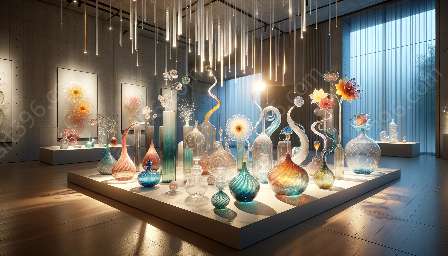As the environmental impact of glass art becomes a growing concern, artists are seeking strategies to make their work more environmentally friendly. By incorporating sustainable practices and materials, artists can minimize their impact on the environment while producing beautiful and innovative glass art. This topic cluster covers the environmental impact of glass art, explores strategies artists can employ to create environmentally friendly glass art, and highlights the importance of sustainability in the art community.
The Environmental Impact of Glass Art
Glass art, while visually stunning, has historically been associated with significant environmental drawbacks. The production of traditional glass art often involves high energy consumption, the release of pollutants, and the depletion of natural resources. Additionally, the disposal of glass waste can contribute to environmental degradation. To address these challenges, artists are now looking for ways to reduce the environmental impact of glass art through sustainable practices and innovative techniques.
Strategies for Creating Environmentally Friendly Glass Art
Artists have several strategies at their disposal to make their glass art more environmentally friendly. These include:
- Recycling and Upcycling: By using recycled glass or repurposing existing glass materials, artists can reduce the demand for new glass production and minimize the amount of glass waste sent to landfills. This approach not only conserves resources but also gives discarded glass a new life as art.
- Utilizing Sustainable Energy Sources: Artists can minimize the carbon footprint of their glass art by using renewable energy sources, such as solar or wind power, for their studio operations. This approach reduces the environmental impact of energy-intensive glassmaking processes.
- Choosing Non-Toxic Materials: Opting for non-toxic or low-impact materials, such as lead-free glass and eco-friendly additives, ensures that the production and handling of glass art do not pose health risks to artists and the environment.
- Implementing Efficient Production Techniques: Adopting efficient glassmaking methods, such as controlled melting processes and optimized kiln firing schedules, can reduce energy consumption and minimize emissions during the creation of glass art.
- Embracing Sustainable Packaging: Artists can further enhance the environmental friendliness of their glass art by using eco-friendly packaging materials and minimizing waste from shipping and handling.
The Importance of Sustainability in Glass Art
By implementing these strategies, artists not only reduce the environmental impact of their work but also contribute to a culture of sustainability within the art community. Environmentally friendly glass art underscores the importance of thoughtful and responsible creation, inspiring other artists and art enthusiasts to consider the ecological footprint of their creative pursuits.
In conclusion, by embracing sustainable practices, utilizing recycled materials, and prioritizing eco-friendly techniques, artists can make their glass art more environmentally friendly without compromising aesthetic appeal. Through these efforts, the art world can lead by example in promoting environmental responsibility and conservation.

